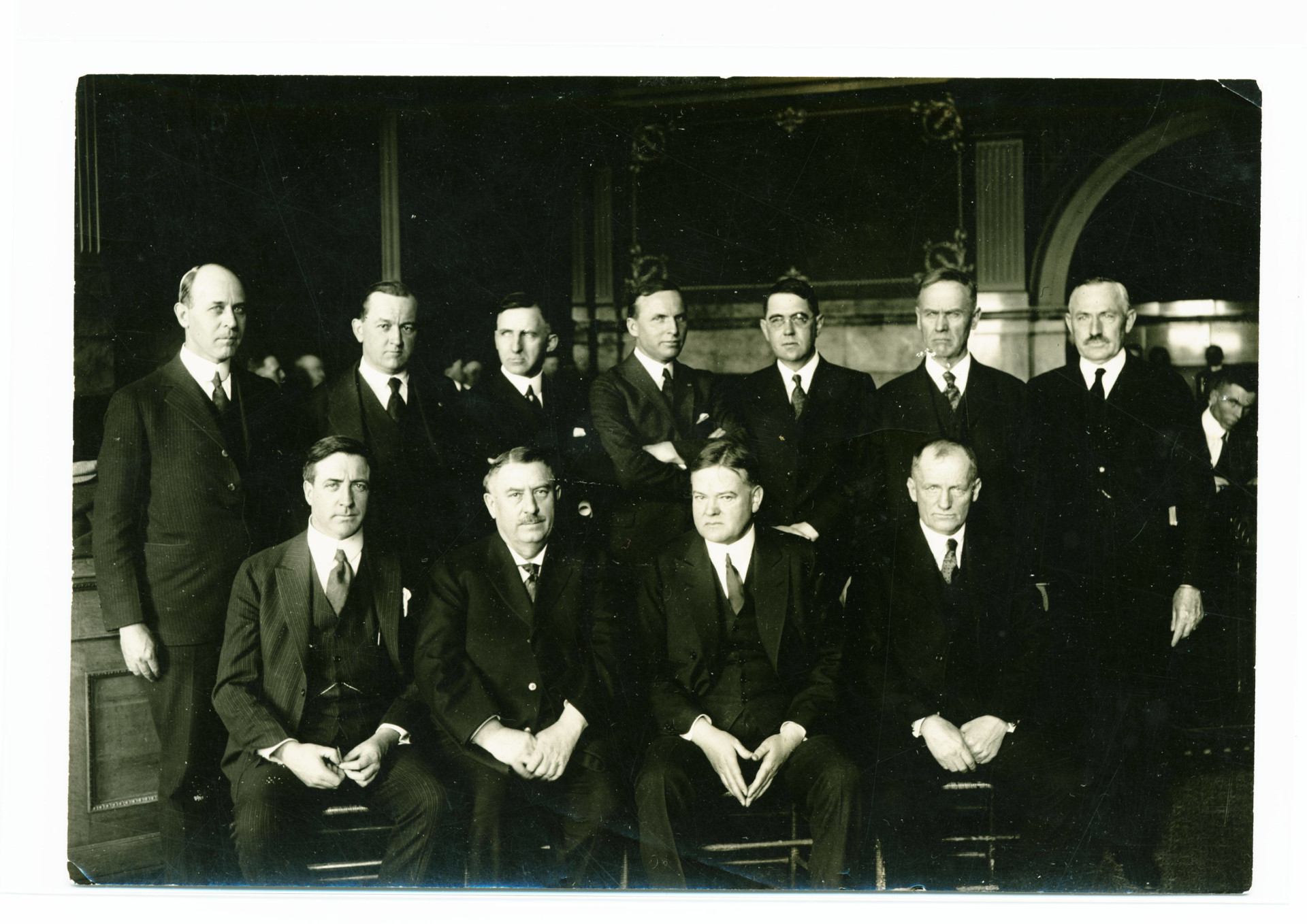
A March 31, 1922 photo of the Colorado River Commission. Standing left to right: Delph E. Carpenter (Colorado), James G. Scrugham (Nevada), R. E. Caldwell (Utah), Frank C. Emerson (Wyoming), Stephen B. Davis, Jr. (New Mexico), W. F. McClure (California) and W. S. Norviel (Arizona). Seated: Gov. Emmet D. Boyle (Nevada), Gov. Oliver H. Shoup (Colorado), Herbert Hoover (federal representative and chair) and Gov. Merritt C. Mecham (New Mexico). The governors were not members of the Commission.
Colorado State University’s Morgan Library is home to a copy of the document that has shaped water in the West for 100 years.
That document – the Colorado River Compact – was signed on Nov. 24, 1922, and governs the allocation of water among the seven states that make up the Colorado River basin.
It has also dominated the news in recent months, as water levels in the river’s two largest reservoirs – Lake Mead and Lake Powell – reach historic lows, prompting concerns about their respective dams’ ability to provide power. Meanwhile, roughly 40 million people in seven states rely on the Colorado River for water.
Patricia Rettig is the archivist for the Water Resources Archive at CSU Libraries. She sat down with SOURCE to discuss the historical significance of the Colorado River Compact and how preserving the past can help guide decisions in the future.

Patricia Rettig is the archivist for the Water Resources Archive at CSU Libraries.
SOURCE: What is the Colorado River Compact and why is it important?
Rettig: The Colorado River Compact is a legal document created in 1922 between the seven Colorado River Basin states and the federal government.
It governs how these seven states share the water coming from the Colorado River.
It marked the first time this many states have come together to make an agreement. Past compacts – which are essentially international treaties between states – typically only involved two entities, so to have seven states and the federal government involved in the river issue was a big deal.
The compact was certainly controversial along the way, there were lots of disagreements and lots of debates, but there was also negotiation and compromise.
How is this 100-year-old document impacting Colorado and the Western U.S. right now?
It basically laid the foundation for everything that was going to happen with the Colorado River going forward.
The states wanted development and to utilize the river for multiple purposes. The compact helped guarantee that each state would have water to use as they continued to grow.
The most obvious outcome of the Colorado River Compact was the construction of the Hoover Dam and the other dams that followed, enabling water storage and hydropower.
In a way, it’s gotten us to where we are today: The compact has enabled municipal water use and irrigation in each of these seven states, and water from the river is also being used to create electricity for homes and industries.
But compared to 1922, there’s a lot more people, and a lot more demand for uses of the river, its water and the power it produces. There are also the environmental issues causing less water to flow through the river in the first place.
The Colorado River basically sustains our way of life in the West, at this point, and it’s shaped by the compact.
Let’s circle back to CSU Libraries: Tell me about the Water Resources Archive.
The Water Resources Archive is working on documenting important water issues in the state of Colorado – but of course that’s also closely tied to what’s happening in the west.
One of our most significant collections deals with the Colorado River Compact and preserves the papers of Delph E. Carpenter, the Colorado water lawyer who came up with the idea of the Colorado River Compact and promoted the idea of other interstate river compacts.
He had researched this idea for years before he was able to convince other people it might be a concept to explore as they worked to solve water issues.
The Delph Carpenter collection documents his research, and we also have the letters he was writing and receiving related to the Colorado River Compact, as well as telegrams. We have drafts he had created to prepare for negotiations – and we have a physical copy of the final compact.
Our collection also includes the reports Carpenter and other people wrote, and all kinds of things that really help us understand the context of not only the times, but what Carpenter himself was working on as he tried to wrestle with these ideas that no one had ever tried before.
Right now, water policy experts are discussing the need to potentially make changes to the Colorado River Compact. Why is it so important to look back at history and learn how we got to this point in the first place?
I think it’s important to look back at the origins of the Colorado River Compact to better understand what the document was meant to do. A lot of people are only looking at the current context, which opens up many avenues for criticism – which are perfectly fair.
But, if people knew the environmental conditions of the time, the demographics of the time, the political issues of the time, there would be a better understanding of why the document is the way it is and what they were trying to achieve.
I also think understanding the history of the compact shows us how amazing it was that seven states were able to come together and make a compromise – which is not exactly something we are seeing these days.
I always hope that by understanding history, we can help the present and the future.
What’s something missing from the current conversations about the Colorado River Compact?
One lapse in understanding I hear is that the federal government told the states to come together and work on a compact – that’s completely wrong. This was entirely up to the states, and the Colorado River Compact was a completely new idea.
The idea of interstate compacts didn’t emerge until 1920, and the Colorado River Compact wasn’t inevitable. It took a full year to get all the state legislatures and federal government on-board.
Delph Carpenter himself had been thinking of this idea for eight years, and the Colorado River Compact is truly a case of an individual who had to convince groups of people that this would be a good way to go forward.
It wasn’t a top-down solution proposed by the federal government – it started at a local level, and is still shaping policy 100 years later.